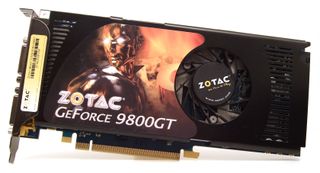Roundup: Mainstream Graphics Cards From ATI And Nvidia
Zotac GeForce 9800 GT 512 MB (GeForce 9800 GT, 512 MB)
To see all the photos in our gallery for this card, click the image below.

ATI and Nvidia are both very aware of where their respective strengths lie, so it's almost humorous that, for a story like this one, it's difficult to get access to many of Nvidia's mainstream offerings. The interest is usually in the company's more powerful products, which sell for more than $150. If you were wondering why there are more ATI cards in this roundup, now you know.
Thanks to Zotac, we were able to procure one GeForce-based test card that comes in around $100 and doesn't have to be shielded from faster competition. This tweaked version of the GeForce 9800 GT is able to keep up with ATI's Radeon HD 4770. Its overall performance lags only 1.1% behind the 40 nm Radeon HD 4770, leaving the Radeon HD 4670 and Radeon HD 4830 far behind.
Zotac does not adhere to reference clock rates, and thereby affords its GeForce 9800 GT some extra muscle. Its GPU clocks in at 660 MHz instead of 600 MHz, and the shaders run at 1,600 MHz instead of 1,512 MHz. The memory clock rate remains unaltered at 900 MHz. This card supports DirectX 10 and comes equipped with 512 MB of GDDR3 RAM. The graphics chip is labeled as G92b, is based on 55 nm process technology, and is a direct successor to the GeForce 8800 GT.
The fan is fairly narrow, enabling this card to fit in a single expansion slot. For an Nvidia card with a low-profile cooler, its temperature readings are typical: 58° C for 2D, and 87° C for 3D under heavy load. By comparison to competing cards, the Zotac GeForce 9800 GT’s power-consumption levels are relatively high, in part because it doesn’t reduce clock speeds in 2D mode—the card consumed 173 W in 2D mode and 292 W in heavy 3D mode. Noise levels measure at a quiet 36.3 dB(A) in 2D mode, but climb to a clearly audible 46.8 dB(A) under heavy 3D loads.
This card is nearly 9.1” long (23 cm) and requires a six-pin PCIe power connector. You’ll find splitter cables in the retail package for both power and component video, plus a DVI-to-HDMI adapter and an internal SPDIF cable to carry digital audio output. You’ll also find XIII Century: Death of Glory in the box as well.
Stay on the Cutting Edge
Join the experts who read Tom's Hardware for the inside track on enthusiast PC tech news — and have for over 25 years. We'll send breaking news and in-depth reviews of CPUs, GPUs, AI, maker hardware and more straight to your inbox.
Current page: Zotac GeForce 9800 GT 512 MB (GeForce 9800 GT, 512 MB)
Prev Page Sapphire HD 4830 512 MB (Radeon HD 4830, 512 MB) Next Page Benchmark Results: Fallout 3-
Bloodblender All I can say is that Tom's recent articles have been an excellent read, and this exactly the stuff I (as well as many others) require for their research purposes. Keep up the great work!Reply -
dirtmountain Nice article,very well done, but you need to show the 4670 in CF as costing $162, not $81 as shown in the final chart.Reply -
rambo117 the iceQ concept is amazing. keeps my 3870s nice and chilly (70C) while hardcore gamingReply
and not to mention they both look intimidating in my case ;) -
to me the gaming benches are most important but energy efficiency and heat dissipation run a close 2nd. thanks for providing it all!Reply
-
Julianbreaker Newegg has quite a few 4850s that retail for $100 and it appears to be getting consistently better benchmarks than the 4770. I am confused as to why you would not recommend it over the 4770. Perhaps you are confused by simple maths.Reply -
radiowars PijQuick question - 4770 in crossfire or single 4890 best bet???..They already did a whole article on that...Reply -
bucifer I don't understand why you still won't use the 1GB version of the Radeon 4870. It's clear to me that the card is limited by it's amount of video memory when using hi-res, AA and AF.Reply
Searching for prices in US and Europe it retails cheaper than the GTX260(192 or 216).
The point is: the card should be included in the test just as the GTX260-216. It's clearly a better option than the 512 mb version and it's good for comparison! -
holodust Nice article, but I don't see how testing these cards on i7 920@3.8 fits into mainstream.Reply
Most Popular

